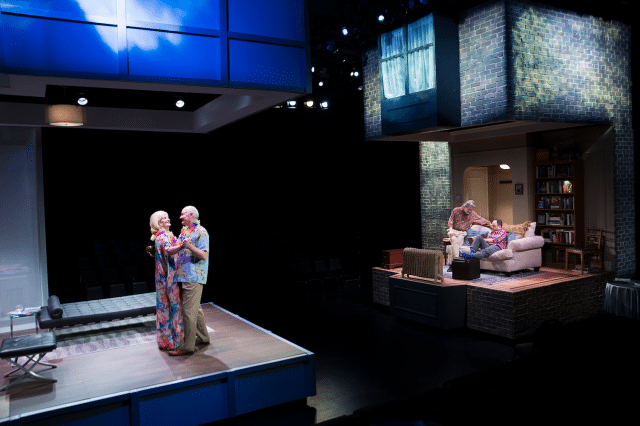

Les Covert (Rob Maitner) must have spent a lot of time watching Alfred Hitchock’s Rear Window, because his MO is straight out of the 1954 classic. He dedicates his free time - of which he seems to have a lot - staring from his modest window apartment, to the luxury building he wishes to live in someday right across the street. He’s become fixated with a family whose members he sees through the window, and has even created a plot about what their daily going ons must mean. Les’ partner Sel Trevoc (John FitzGibbon) is a philosophy professor and never has anything even remotely intelligent or observant to say about his partner’s bizarre obsession. That alone should serve as a red flag for the implausibility of Wendy Beckett’s A Better Place, a show intent on making things happen exclusively to serve its dramatic purpose.
Rather than pairing characters, it clumps them together to create scenes and situations the playwright deems as comedic or profound. At one point, the envious, petty Les comes into possession of a briefcase containing the “future” of the family he envies so much. We’re supposed to go “ah, how the tables have turned”, but the character we’re supposed to be rooting for is so despicable that it’s hard to see past our founded biases. The people across the street don’t fare much better, the father John (Edward James Hyland) is a gambler who constantly neglects his wife Mary (Judith Hawking). They live with their daughter Caroline (Jessica DiGiovanni) an adult-child who has never worked because she was raised to believe she is extremely wealthy, and instead has developed a real estate fetish. She gets off on realtor slang, and pouts “we’ve already done Tribeca!” when her lover (Michael Satow) speaks of downtown buildings.
If there is one constant thought that plagues the mind watching the show unfold is: how did these people end together? Why, even? The characters exist only as theatrical tools meant to explain the whims of fate and serendipity, but they are so inhuman (as in synthetic creations, not un-noble or kind) that one wonders if they were mostly meant to highlight the beauty of the set. And it truly is a set worthy of endless praise! Courtesy of David L. Arsenault, we are treated to a double stage divided by a path that separates the audience into two sections, while marking the profound division between the older building and the sleek monolith across the street. The show could’ve done more digging at the deep social inequity in America, or even commented on materialism and the false idea that the bigger the house, the stronger the home. The show’s one benefit is it will make going back home feel like you’re en route to heaven.